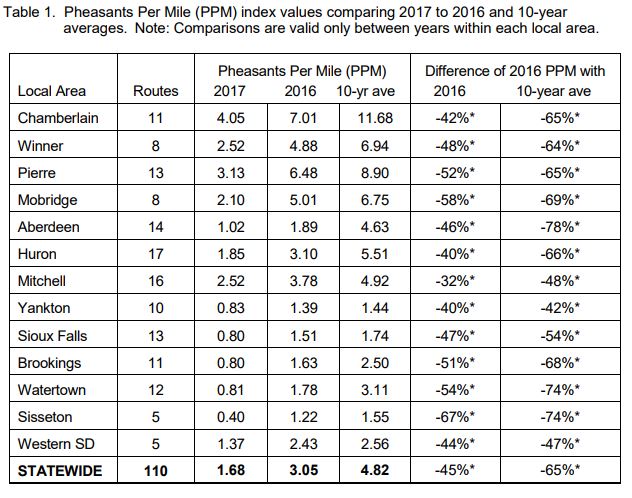South Dakota's pheasant counts have dropped. But there are still roosters for those willing to scout, and hunt, hard.
By Tom Carpenter
“The statewide Pheasants Per Mile (PPM) index for the 2017 pheasant brood survey decreased
45% (3.05 to 1.68) compared to the 2016 statewide index,” reports Travis Runia, Senior Upland Game Biologist with South Dakota Game, Fish and Parks.
“This year’s index is 65% lower than the 10-year average (2017 = 1.68, 10-year average = 4.82),” says Runia. “Compared to 2016, fewer roosters, hens and broods were counted throughout the 110 survey routes we run in the state. Statewide, 16 routes of the 110 surveyed showed an increase in PPM from 2016.”
.JPG.aspx)
Since we’re diving into tough numbers here before we look for better insights, let’s make two points:
*South Dakota game managers are sure routes were conducted under good conditions. “Many routes were surveyed more than once in an attempt to get at least one survey completed under prime conditions – clear skies, heavy dew, light winds,” says Runia.
*Rooster numbers remained similar to 2016 while hen counts decreased 35% and brood counts by 44%. Brood size was very low, at 4.99 chicks per brood.
Bad News, Respectable Hunting
Yes the news may be rough out of South Dakota and there is no sugarcoating it. A bad winter, a drought – and the biggest killer of all, habitat loss – has South Dakota pheasant numbers down. But the state still has more birds than anywhere else, and regions and zones with good cover. Pheasant hunters will do well to come, work hard and hunt with purpose.
Jared Wiklund, Public Relations Manager for Pheasants Forever, offers the following insight: “In 2013, South Dakota witnessed it’s modern day low pheasant roadside survey index at 1.52 pheasants per mile, a preseason population of 6.2 million pheasants, and a rooster harvest of just under a million birds.”
“To put it all in perspective,” he continues, “the roadside counts for 2017 are higher than several years ago and are foreshadowing a rooster harvest statistic, most likely around the one million bird mark, that should have upland hunters itching for the season to start. It’s still the pheasant capital of the world, and I for one will be making the annual pilgrimage over the border with my dogs to take part in South Dakota’s legendary upland traditions.”
Runia thinks similarly. “Although pheasant abundance is below last year and the ten-year average,” says Runia, “there is still opportunity for quality pheasant hunting across the state.”
“At the statewide level, pheasant abundance is similar to 2013, when pheasant harvest was a respectable 980,000,” he confirms. “And the Pierre, Chamberlain, Winner, and Mitchell areas are above 2013 levels this year.”
"Hunters have harvested more than 1 million birds in each of the last three years, or 9.5 birds per hunter, per year,” adds Jim Hagen, Secretary of the South Dakota Department of Tourism.
Pheasant harvest could – read could – still approach a million birds: That is, if hunters come and hunt.
“Another bright spot is the addition of 8,000 acres of high quality habitat to our 1.2 million acrea Walk-in Area Program, which opens private lands to public hunting,” adds Runia. “Most of the additions are enrolled in CRP. Enrollment was partially funded by an NRCS Voluntary Public Access grant.”
Important South Dakota Note
“With the drought conditions, emergency haying and grazing was necessarily authorized on most CRP,” says Runia. Farmers and ranchers needed the help. “Hunters should spend some time scouting their intended hunting areas this year. Birds could be concentrated in remaining cover which should reward the well-prepared hunters.”
If you an encounter a mowed or grazed field, remember three critical ideas.
1) The farmer or rancher needed that grass: to feed his or her livestock and make a living.
2) Pheasant hunters always need to partner with farmer and ranchers, and this is part of the conservation deal: the wise use of resources.
3) That disturbance is going to make the grass come back stronger and more vibrant: better habitat for the future, when rains will return and South Dakota’s pheasant counts will improve.
A Call-to-Action
Still, Runia puts it bluntly, and it’s a call-to-action to every Pheasants Forever member to stay engaged: “Loss of upland habitat has been a major contributing factor to the decline in the pheasant population,” he says. “Without improvements in habitat loss trends, we should not expect major improvements in the pheasant population, even when environmental conditions are favorable.”
South Dakota Hunting Tip
*“The traditional opening day on the third Saturday in October is the most popular weekend to hunt pheasants,” says Runia. “However, hunting success improves later in November as crops are harvested and birds become more accessible.” That could be an especially important concept this year, as scarcer birds concentrate in blocks of good cover.
Links
South Dakota 2017 Brood Survey Report
South Dakota Walk-In Program
South Dakota Public Lands Summary
Tom Carpenter is Digital Content Manager for Pheasants Forever.